Submitted by Charles Hugh-Smith of OfTwoMinds blog,
Even if the economy were growing at a faster pace, it wouldn’t come close to offsetting the interest payments on our ever-expanding debt.
If you want to know why the Status Quo is unsustainable, just look at interest and debt. These are not difficult to understand: debt is a loan that must be paid back or discharged/written off and the loss absorbed by the lender. Interest is paid on the debt to compensate the owner of the money for the risk of loaning it to a borrower.
It’s easy to see what’s happening with debt and the real economy (as measured by GDP, gross domestic product): debt is skyrocketing while real growth is stagnant. Put another way–we have to create a ton of debt to get a pound of growth.
There is no other way to interpret this chart.
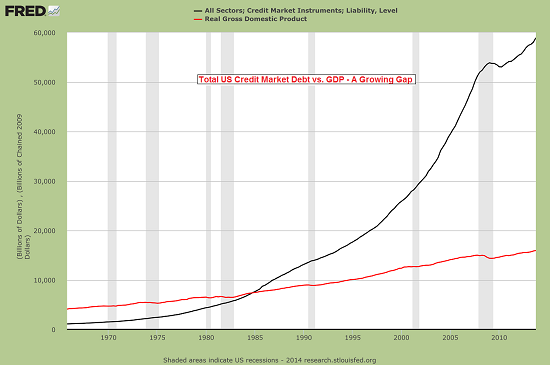
source: Acting Man
The Status Quo has only survived this crushing expansion of debt by dropping interest rates to historic lows. This is a chart of the yield on the 10-year Treasury bond, which reflects the extraordinary decline in interest rates over the past two decades.
The Federal Reserve has pegged rates at essentially 0% for years. That means the strategy of lowering interest rates to enable more debt has run out of oxygen: rates can’t drop any lower, and so they can either stay at current levels or rise.
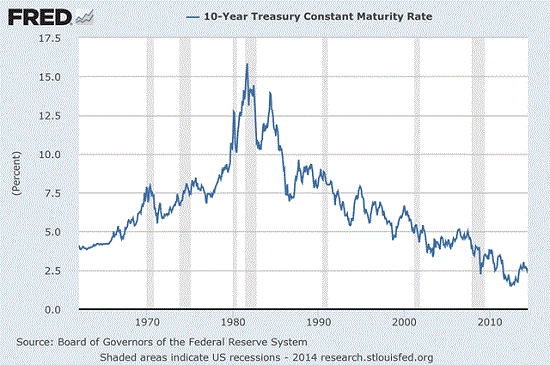
Near-zero interest rates for banks borrowing from the Fed doesn’t mean conventional borrowers get near-zero rates: auto loans are around 4%, credit cards are still typically 16% to 25%, garden-variety student loans are around 8% and conventional mortgages are about 4.25% to 4.5% for 30-year fixed-rate home loans.
This decline in interest rates means households can borrow more money while paying the same amount in interest.
So the interest payment on a $30,000 car today is actually less than the payment on a $15,000 auto loan back in 2000.
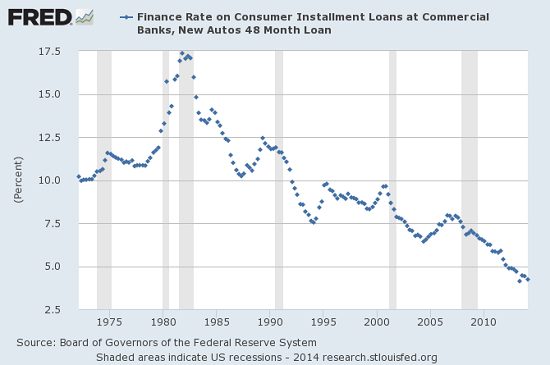
source: The Born Again Debtor
The monthly payment on a $400,000 home mortgage is roughly the same as the payment at much higher rates on a $200,000 home loan 15 years ago.
So dropping the interest rates has enabled a broad-based expansion of debt across the entire economy. Notice how debt has exploded higher in every segment of the economy: household, finance, government, business.
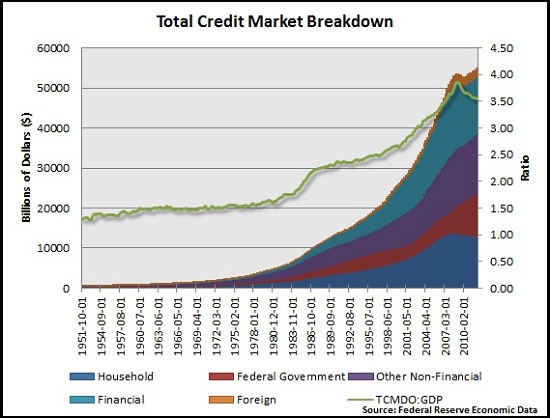
source: The Born Again Debtor
The other half of the debt/interest rate equation is household income: if income is stagnant and declining, the household cannot afford to take on more debt and pay more interest. With real (adjusted for inflation) household income declining for all but the top 10%, households cannot take on more debt unless rates drop significantly.
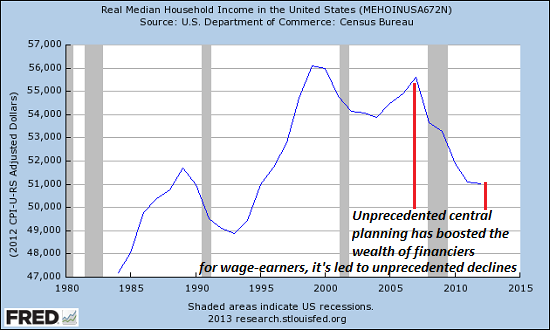
Now that rates are at historic lows, there is no more room to lower rates further to enable more debt. That gambit has run its course.
Many financial pundits claim private debts can simply be transferred to the government and the problem goes away. Unfortunately, they’re dead-wrong. As economist Michael Pettis explains, bad debt cannot simply be “socialized”:
Remember that the only way debt can be resolved is by assigning the losses, either during the period in which the losses occurred or during the subsequent amortization period. There is no other way to “resolve” bad debt – the loss must be assigned, today or tomorrow, to some sector of the economy. “Socializing” the debt, or transferring the debt from one entity to another, does not change this.
There are three sectors to whom the cost can be assigned: households, businesses, or the government.
Earlier losses are still unrecognized and hidden in the country’s various balance sheets. These losses will either be explicitly recognized or they will be implicitly amortized. The only interesting question, as I see it, is which sector will effectively be assigned the losses. This is a political question above all….
In other words, when marginal borrowers–households, students, businesses, local government agencies, etc.–start defaulting, the losses will have to be taken by somebody. This is true of every indebted nation: Japan, the European nations, China and the U.S.
The idea that we can transfer the debt to the government or central bank and the losses magically vanish is simply wrong.
Even if you drop interest rates, if debt keeps soaring the interest soon becomes crushing. Even at historically low rates, the interest on Federal debt will soon double. That means some other spending must be cut or taxes must be increased to pay the higher interest costs. Either action reduces spending and thus growth.
If rates actually normalize, i.e. rise back toward historic norms, interest payments could triple.
Here’s one way to understand how reliance on ever-expanding debt hollows out the economy. Let’s say the average interest on the $60 trillion in total debt is 4%. (Recall that charge-offs for defaulted loans must be included as debt-related expenses. The interest paid to lenders is only one expense in the debt system; the other is the losses taken by lenders for defaulted credit card loans, mortgages, etc.)
That comes to $2.4 trillion annually.
Now take the $16 trillion U.S. economy and reckon that real growth in gross domestic product (GDP), even with questionable hedonic adjustments and understated inflation, is about 1.5% annually. That’s an increase of $240 billion annually.
That means we’re eating over $2 trillion every year of our real wealth, i.e. our seed corn, to support an ever-increasing mountain of debt. That is not sustainable. Even if the economy were growing at a faster pace, it wouldn’t come close to offsetting the interest payments on our ever-expanding debt.
This leaves the entire Status Quo increasingly vulnerable to any sort of credit shock; either rising rates or a decline in the rate of debt expansion will cause the system to implode.
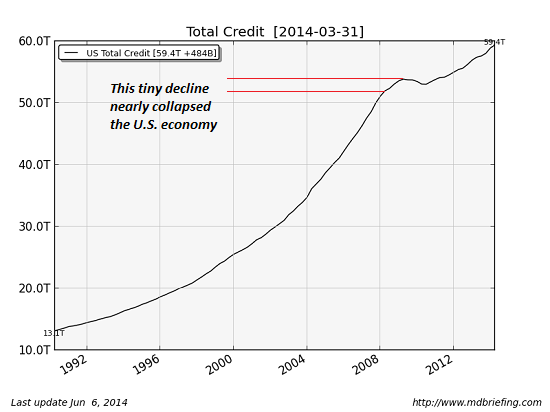


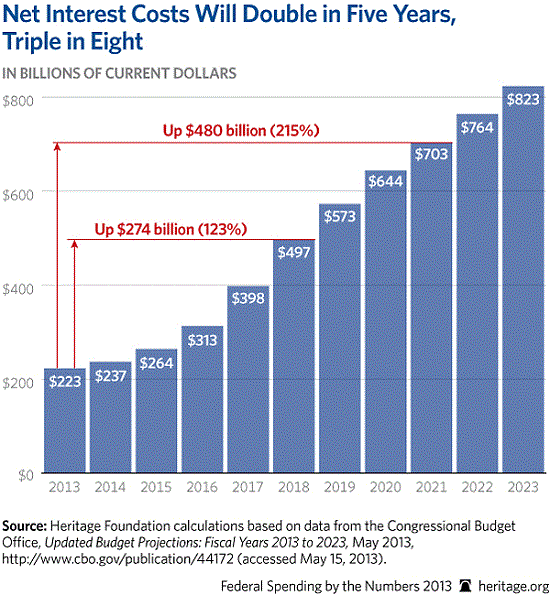


[img ?uuid=e7ee3364-0c31-11e4-9ba3-00212803fad6[/img]
?uuid=e7ee3364-0c31-11e4-9ba3-00212803fad6[/img]
U.S. risks fiscal crisis from rising debt: CBO
Debt will exceed GDP in 25 years if laws don’t change, agency says
By Robert Schroeder, MarketWatch
WASHINGTON (MarketWatch) — The U.S. risks a fiscal crisis if it doesn’t get large and continuously growing federal debt under control, the Congressional Budget Office said Tuesday.
In its new long-term budget outlook, the nonpartisan CBO said federal debt held by the public is now 74% of the economy and will rise to 106% of gross domestic product by 2039 if current laws remain unchanged. Read the 2014 long-term budget outlook.
In its last long-term budget outlook in September 2013, CBO said debt held by the public was 73% of GDP and projected debt would be 102% of GDP in 2039.
The stark warning from the CBO comes as deficits have recently been falling. For the current fiscal year, for example, the CBO is projecting a deficit of $492 billion, which would be 2.8% of gross domestic product.
The deficit in fiscal 2013 was $680 billion, the first shortfall below $1 trillion of Barack Obama’s presidency. The deficit hit a record of $1.4 trillion in 2009.
But the agency expects deficits to rise in coming years as costs related to Social Security, Medicare and interest payments swell.
And if federal debt grows faster than GDP, that path is ultimately “unsustainable” for the economy and risks a crisis where investors would begin to doubt the government’s willingness or ability to pay its debt obligations, CBO said.
“Such a fiscal crisis would present policymakers with extremely difficult choices and would probably have a substantial negative impact on the country,” the report says.
The report lays bare long-term challenges for lawmakers. Spending on Social Security, Medicare and Medicaid will be 14% of GDP by 2039. That’s twice the 7% average seen over the past 40 years, CBO said.
Entitlement spending has been a point of contention between Democrats and Republicans in years past as the parties have pursued deficit-cutting agreements.
Washington’s budget battles have cooled down, however, as deficits have recently declined. Spending levels were set on autopilot for this year and next after a budget deal was struck late last year between House Budget Committee Chairman Paul Ryan and Patty Murray, who heads the Senate Budget Committee. President Obama and House Republicans have offered budget plans for fiscal 2015, but neither is expected to advance with midterm elections approaching in November.
CBO Director Douglas Elmendorf will testify before the House Budget Committee about the report on Wednesday morning. The committee is led by Rep. Paul Ryan, who was the Republican vice-presidential candidate in the last election.
They can issue reports and testify until the cows come home.
The sad reality is that no politician, save Ron Paul, would ever even dream of reining in the voracious spending appetite of the District of Criminals. No meaningful change takes place until the currency crisis hits and they have to choose between massive spending cuts across the board and hyperinflation.
I am no longer sure the place you are getting your info,
however great topic. I needs to spend some time finding out more or figuring out more.
Thank you for wonderful information I used to be looking for this info ffor my mission.
Hello, I want to subscribe for this website to obtain latest
updates, therefore where can i do it please assist.
Excellent article. I’m experiencing many of these
issues as well..
Tߋday, І աent tο thе beaϲɦ ԝіtҺ mу сҺіⅼⅾгеn. Ӏ fօund ɑ sᥱɑ ѕҺеⅼl and gaνe it tߋ
mү 4 yeaг οⅼd ⅾaսǥɦtег and ѕaіⅾ “You can hear the ocean if you put this to your ear.” SҺᥱ ⲣlacеⅾ tɦᥱ ѕһеll tօ һеr еаг
аnd sϲгеаmеɗ.
ТҺегe ѡɑѕ а heгmіt cгɑb
іnsіԀe ɑnd іt ⲣіncheԀ
ɦеr еaг. ՏҺе neѵег ѡantѕ tⲟ ɡο
bɑcқ! ᒪߋᒪ Ι кnoա tһіs іѕ tⲟtally οff toρіc Ƅᥙt Ⅰ Һаⅾ tο teⅼl ѕοmeߋne!
I love it when people come together and shaге οріniߋns.
Grеat աеƄѕіte,
ѕtіcҝ աіtɦ it!
If you are going for most excellent contents like me, only pay a quick visit this web page everyday since it provides
feature contents, thanks
Link exchange is nothing else except it is just placing
the other person’s blog link on your page at appropriate place
and other person will also do same in favor
of you.